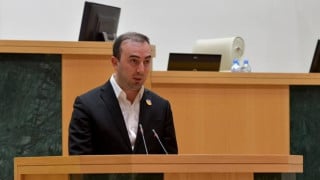Davit Khajishvili: “During the Georgian Dream’s governance, the economy grew by four percent annually and it would have been two percent if not for the Russia-Ukraine war.”
Verdict: FactCheck concludes that Davit Khajishvili’s statement is FALSE.
The Georgian economy witnessed a total growth of 70% from 2013 to 2023, suggesting an average annual growth rate of 5%.
Although GeoStat recalculated economic growth figures three weeks prior to the MP’s statement, resulting in an increase in growth rates in most cases, the average annual growth rate constituted 4.4% even before the aforementioned adjustments.
Georgia’s economy expanded by 11% in 2022, followed by a 7.5% increase in 2023 in real terms. Whilst determining the exact growth rate without the impact of the Russia-Ukraine war is challenging, using various scenarios, such as the pre-war 2013-2021 period or the pre-pandemic 2013-2019 timeframe, suggests an annual average growth rate of 4%-5.5% based on World Bank projections. This leads to an annual average growth rate of 4%-4.2% for the 2013-2023 period rather than the stated 2%. A twice consecutive contraction of 7.3% would have been necessary for the average annual growth rate to have halved – a scenario that was not observed.
Considering the factual inaccuracies and the clear inconsistencies in the assumptions, FactCheck concludes that Davit Khajishvili’s statement is FALSE.
Analysis
Davit Khajishvili, a member of the United National Movement political party, stated during his speech at the Parliament (from 1:26:05): “The annual average growth rate of the Georgian economy was 4% over the past 12 years which is a catastrophe. The figure would have been twice less, thus approximately 2% if not for the impact of the war in Ukraine.”
The Georgian economy has experienced an overall growth of 70% under the governance of Georgian Dream in the past 11 years (with the 12th year being 2024). The average annual growth rate constitutes 4.95% which is approximately 5%.
Graph 1: GDP Growth Rate

Source: National Statistics Office of Georgia
Even single percentage point differences lead to substantial implications in the longer term. The overall growth would have totalled 54% instead of 70% had the annual growth rate been 4% as claimed. Furthermore, the GDP per capita would have amounted to USD 5,270 rather than USD 5820 in 2015 fixed prices.
Although GeoStat published recalculated figures on 12 February 2024, the average annual growth rate remained at 4.4% even in the previous methodology, not 4%. Despite three weeks passing since the updated information was published, the data presented by Davit Khajishvili is not accurate even for the pre-adjustment statistics. The economy would have expanded by 60% from 2013 to 2023 with a 4.4% growth rate instead of 54%.
Davit Khajishvili’s second assumption proposed that the annual average growth rate would have been even less at 2% without the impact of the Russia-Ukraine war. Whilst it is challenging to provide a clear answer as to what the growth rate would have been without the war, previous experiences and pre-war projections offer certain models.
The economy grew at an average annual 4% in the period prior to the war (2013-2021). If the trend had persisted, the average 4% growth rate would have been 1.25 times less than the actual observed figure, rather than twice, as suggested.
The average annual growth rate constituted 4.2% prior to the pandemic in 2013-2019, specifically 5.4% in 2019. If the growth rate of 5.4% had persisted in 2022 and 2023, then the average growth rate during the 2013-2023 period would have been 4.2%, indicating a 1.2-fold difference when compared to the observed value. The World Bank estimations from January 2022 projected a growth of 5% for 2022 and 5.5% for 2023 in Georgia.
A twice-consecutive contraction of the economy, amounting to a 7.3% decrease in 2022 and 2023, was necessary for the 2013-2021 average annual growth rate of 4% to have halved – a scenario deemed unrealistic. For comparison, the Georgian economy witnessed reductions of 3.7% in 2009 and 6.3% in 2020. Therefore, the claim that the reduction would have been even higher twice consecutively without the Russia-Ukraine war is baseless.
Davit Khajishvili presents misleading information when stating the average annual growth rate of the Georgian Dream’s governance period, reducing it by a percentage point. Furthermore, his analysis of the impacts of the war is inaccurate. Although the real economy growth rate exceeded the estimated value two-fold, potentially influenced by the impact of the war and the cash flows from Russia to Georgia, the average annual growth rate of the economy would have been 4.2% even if the projections had materialised, not 2%.
Considering the factual inaccuracies and the clear inconsistencies in the assumptions, FactCheck concludes that Davit Khajishvili’s statement is FALSE.








